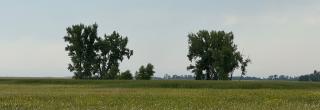
The Cottonwoods Know Better Than GPS
Dr. Steven L. Johnson
The call came one August morning after nearly 2 inches of rain had soaked the ground.
My wife and I were planning our 47th wedding anniversary when a number I didn’t recognize lit up my phone.
On the other end was a nervous young voice.
He and his buddy were scouting for geese and had pulled my name from onX Hunt.
They were stuck — badly stuck.
He rattled off street names that didn’t mean much out here.
When I asked about landmarks, he mispronounced a few landowners’ names before finally describing six big Cottonwoods around a waterhole.
I knew exactly where they were — the same swampy stretch where I once pulled out deer hunters after four long hours.
I just hoped they had mosquito repellent, because after that much rain the skeeters were thick enough to carry you away.
I told him it would take a tractor and 6 miles of backtracking.
My wife reminded me I couldn’t just leave them.
Out here, who really has the equipment, time, and willingness to pull you out of a swamp?
When I arrived, one boy was waiting at the county line.
He hopped in, helped me unhook the discbine, and rode in the tractor’s buddy seat.
On the way, I learned they were juniors from West Fargo — not just “west of Fargo,” as he first claimed.
GPS may get you close, but it won’t tell you which roads are impassable — even to a four-wheel drive tractor.
We pulled their pickup free.
The boys shook my hand again and again, asking what they owed me.
“Nothing,” I told them. “Just send me a thank you note. Out here, mistakes happen. But that’s how you learn.”
Technology can point a direction, but it doesn’t know the land like those who work it every day.
Out here, survival depends not on satellites, but on neighbors willing to drop everything, unhook the haying equipment, and fire up the tractor.
- Dr. Steven L. Johnson is a fourth-generation North Dakotan, rancher, and rural educator. He serves as superintendent of Fort Ransom School District and still works cattle with his family.
